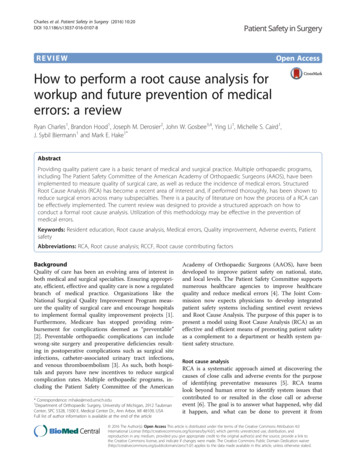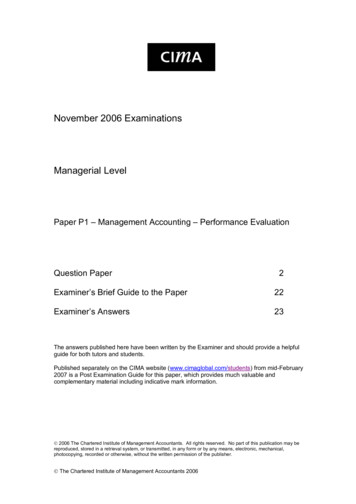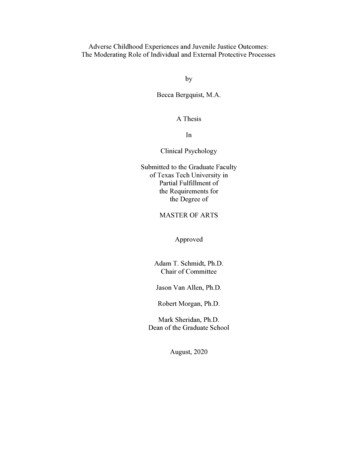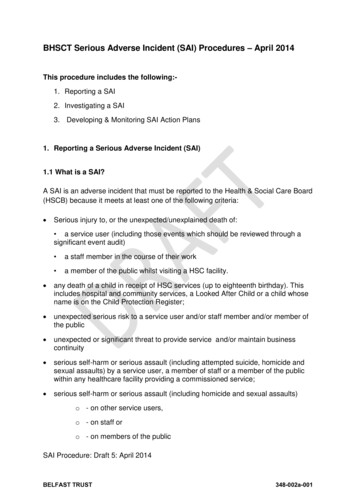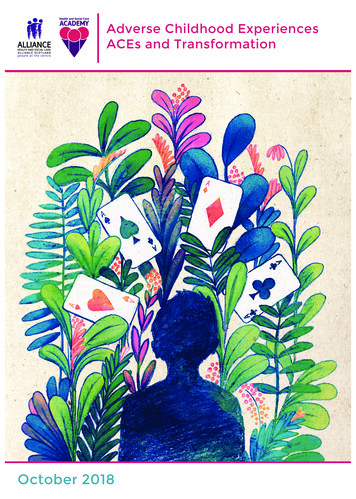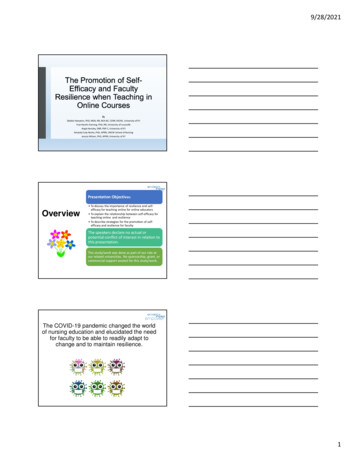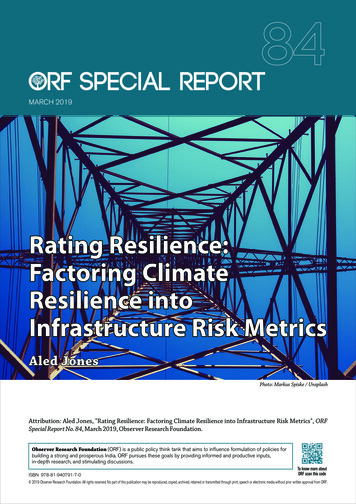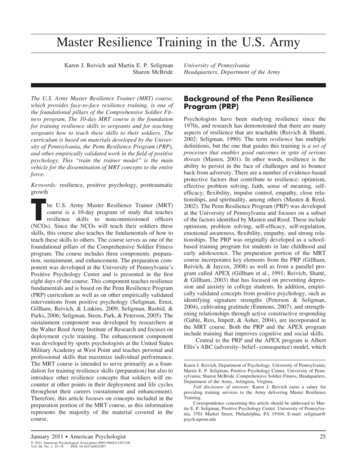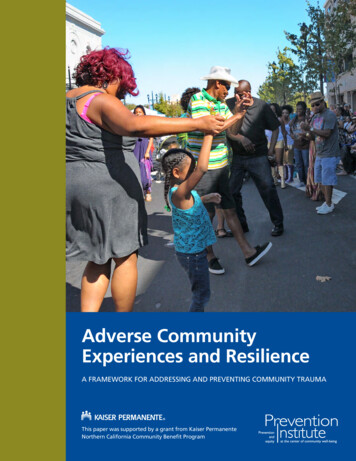
Transcription
Adverse CommunityExperiences and ResilienceA FRAMEWORK FOR ADDRESSING AND PREVENTING COMMUNITY TRAUMAThis paper was supported by a grant from Kaiser PermanenteNorthern California Community Benefit Program
ContentsFunding and Authorship. . . . . . . . . . . . . . . . . . . . . . . . . . . . . . . . . . . . . . . . . . . . . . . . . . . . . . . . . 1Acknowledgements. . . . . . . . . . . . . . . . . . . . . . . . . . . . . . . . . . . . . . . . . . . . . . . . . . . . . . . . . . . . . 2Executive Summary. . . . . . . . . . . . . . . . . . . . . . . . . . . . . . . . . . . . . . . . . . . . . . . . . . . . . . . . . . . . . 3Introduction: The Need for Understanding Trauma at a Community Level. . . . . . . . . . . . . . . . 7Themes and Findings. . . . . . . . . . . . . . . . . . . . . . . . . . . . . . . . . . . . . . . . . . . . . . . . . . . . . . . . . . . . 9A. There is growing understanding about trauma, particularly its prevalence and impact.The predominant approach to dealing with trauma is screening and treatment,consistent with a medical model . . . . . . . . . . . . . . . . . . . . . . . . . . . . . . . . . . . . . . . . . . . . . . . . . . 91. Trauma is pervasive . . . . . . . . . . . . . . . . . . . . . . . . . . . . . . . . . . . . . . . . . . . . . . . . . . . . . . . 92. Trauma has a significant impact on development, health, and well-being . . . . . . . . . . . . . . 93. Concepts of poly-victimization, complex trauma are changing researchon multiple exposures to violence, trauma . . . . . . . . . . . . . . . . . . . . . . . . . . . . . . . . . . . . . 104. Trauma-informed care is becoming a standard of care . . . . . . . . . . . . . . . . . . . . . . . . . . . . 105. The main construct for addressing individual trauma is basedon a medical model . . . . . . . . . . . . . . . . . . . . . . . . . . . . . . . . . . . . . . . . . . . . . . . . . . . . . . 10B. Trauma manifests at the community level. There are emerging practices to addresstrauma at the community level, yet there is not a framework for addressing andpreventing it . . . . . . . . . . . . . . . . . . . . . . . . . . . . . . . . . . . . . . . . . . . . . . . . . . . . . . . . . . . . . . . . 116. In high-violence neighborhoods, it’s widely believedthat whole communities are traumatized . . . . . . . . . . . . . . . . . . . . . . . . . . . . . . . . . . . . . . 117. Recently, there has been a slight shift toward understandingtrauma as collective . . . . . . . . . . . . . . . . . . . . . . . . . . . . . . . . . . . . . . . . . . . . . . . . . . . . . . 118. The predominant focus for addressing trauma remains at the individual level . . . . . . . . . . 129. Trauma is a barrier to effective solutions to promote health,safety, and well-being . . . . . . . . . . . . . . . . . . . . . . . . . . . . . . . . . . . . . . . . . . . . . . . . . . . . 1210. Community trauma symptoms are in the social-cultural,physical/built, and economic environments . . . . . . . . . . . . . . . . . . . . . . . . . . . . . . . . . . . . 1311. Emerging practices address community trauma,including indigenous-based healing and restorative justice . . . . . . . . . . . . . . . . . . . . . . . . .1712. No current framework defines community traumaand identifies its symptoms, which is needed . . . . . . . . . . . . . . . . . . . . . . . . . . . . . . . . . . . 1813. There is an uneven level of capacity to conceptualizeand address community trauma . . . . . . . . . . . . . . . . . . . . . . . . . . . . . . . . . . . . . . . . . . . . . 19The Production of Trauma from Violence . . . . . . . . . . . . . . . . . . . . . . . . . . . . . . . . . . . . . . . 20Towards a Framework for Community Trauma and How to Address and Prevent It. . . . . . . 22Fostering Resilient, Thriving Communities . . . . . . . . . . . . . . . . . . . . . . . . . . . . . . . . . . . . . . . . . . 26Promoting Community Resilience: From Trauma to Well-being . . . . . . . . . . . . . . . . . . . . . 28Conclusion: It’s Time to Take on Adverse Community Conditions. . . . . . . . . . . . . . . . . . . . . . 30References . . . . . . . . . . . . . . . . . . . . . . . . . . . . . . . . . . . . . . . . . . . . . . . . . . . . . . . . . . . . . . . . . . . 33Figure 1Figure 2Figure 3Figure 4Figure 5The Community Environment. . . . . . . . . . . . . . . . . . . . . . . . . . . . . . . . . . . . . . . . . . . .The Production of Trauma from Violence. . . . . . . . . . . . . . . . . . . . . . . . . . . . . . . . . .Community Strategies to Address Community Trauma. . . . . . . . . . . . . . . . . . . . . . .Elements of a Resilient Community. . . . . . . . . . . . . . . . . . . . . . . . . . . . . . . . . . . . . . .Promoting Community Resilience: From Trauma to Well-being. . . . . . . . . . . . . . . .1321232629Cover photo provided by Richmond Main Street Initiative
Funding and AuthorshipThis paper was made possible by a grant to Prevention Institute from Kaiser PermanenteNorthern California Community Benefit Program.Principal AuthorsHoward Pinderhughes, Ph.D. Rachel A. Davis, M.S.W. Myesha Williams, M.S.W.Prevention Institute is a nonprofit, national center dedicated to improving communityhealth and well-being by building momentum for effective primary prevention. Primaryprevention means taking action to build resilience and to prevent problems before they occur.The Institute’s work is characterized by a strong commitment to community participation andpromotion of equitable health outcomes among all social and economic groups. Since itsfounding in 1997, the organization has focused on community prevention, injury and violenceprevention, health equity, healthy eating and active living, positive youth development, healthsystem transformation and mental health and well-being. For more information, visitwww.preventioninstitute.org.Howard Pinderhughes is an Associate Professor in the School of Nursing at UC San Francisco.His focus areas include sociological theory; youth violence and adolescent health; race, ethnicity,and health inequality; and social change. The author of Race in the Hood: Conflict and ViolenceAmong Urban Youth, Pinderhughes has examined the dynamics of racial violence. In DealingWith Danger: How Inner City Youth Cope with the Violence that Surrounds Them (forthcoming)he examines the production of youth violence and how urban adolescents think about andexperience violence and trauma. Additionally, Pinderhughes was Co-Principal Investigator for theCenter on Culture, Immigration and Youth Violence Prevention, one of the Centers for DiseaseControl and Prevention’s Academic Centers of Excellence in Youth Violence Prevention. He is onPrevention Institute’s UNITY team, working with US cities to prevent violence.Kaiser Permanente is recognized as one of America’s leading healthcare providers andnot-for-profit health plans. Recognizing its unique role as both a healthcare provider andcommunity partner Kaiser Permanente provides funding and clinical expertise to work side-byside with other organizations to address serious public health issues such as violence and obesity.Through its Adverse Childhood Experiences (ACE) Study, conducted with the Centers for DiseaseControl and Prevention, Kaiser Permanente demonstrated the connection between violencerelated trauma and the long-term health of individuals. Through its Healthy Eating Active Living(HEAL) investments the organization promotes community healing with support for individuals,families and safe public spaces. In 2014, Kaiser Permanente provided more than 18 millionto build healthy, safe environments in northern California alone. For more information visitkp.org/communitybenefit/ncal.Pinderhughes H, Davis R, Williams M. (2015). Adverse Community Experiences and Resilience:A Framework for Addressing and Preventing Community Trauma. Prevention Institute, Oakland CA.Adverse Community Experiences and Resilience1
AcknowledgementsPrevention Institute is grateful to Kaiser Permanente Northern California Community BenefitProgram for supporting the development of this paper. We particularly want to thankJodi Ravel, Senior Manager, Regional Community Benefit Programs for her support andcontributions to the development of this paper. We are also grateful to the many members of theUNITY City Network who have shared their experiences of working in high-violence communitieswith us and with each other, which has informed the development of this body of work. Finally,we thank the following people from the Northern California cities of San Francisco, Oakland,Richmond, Vallejo, South Sacramento, Stockton and Fresno who shaped our understanding ofthe current landscape through interviews:Ellen Brownformer Community Benefit Managerfor South Sacramento, Kaiser PermanenteKanwarpal DhaliwalDirector of Community Healthand Integrative Practice, RYSEPaul FloresManager, Latino Men and Boysat the UNITY CouncilKrista GirtyDirector, Huckleberry Youth Health CenterChristina GoetteDirector, Shape Up SFJim IlligCommunity Benefit Manager for SanFrancisco, Kaiser PermanenteGreg KingFounder and CEO, Always KnockingMargo LeviClinical Director,Huckleberry Youth Health CenterDeAngelo MackSVIP Program Coordinator,Wellspace HealthTariq MohammadOrganizer, Families and Fathers of San JoaquinSusan NeufeldVice President Resident Programs and Services,Bridge HousingSamuel NunezExecutive Director,Families and Fathers of San JoaquinMarie SanchezCommunity Benefit Manager for Modesto,Stockton, San Joaquin County and Stanislaus,Kaiser PermanenteKevin SharpsExecutive Director, Fighting Back PartnershipKyndra SimmonsProgram Manager, Caught in the CrossfireIvonne Der Torosianformer Community Benefit/Community HealthManager for Fresno, Kaiser PermanenteCynthia VerrettCommunity Benefit Manager for Napa-Solano,Kaiser PermanenteAdverse Community Experiences and Resilience2
EXECUTIVE SUMMARYA Framework for Addressing andPreventing Community TraumaIntroductionMany communities are working to prevent violence and promote community safety and,through comprehensive, multi-sector actions, are making progress. However, communities thatexperience high rates of violence continue to be plagued with persistently high rates of trauma.Trauma and its associated symptoms of mental and psychological illness are more prevalent inthe U.S. than in most other countries in the world. What’s more, trauma can be a barrier to themost successful implementation of healing and well-being strategies, including those to preventviolence.The impact of trauma extends beyond the individuals who directly witness or experienceviolence. Trauma is also produced by structural violence, which prevents people and communitiesfrom meeting their basic needs. The result is both high levels of trauma across the populationand a breakdown of social networks, social relationships and positive social norms across thecommunity — all of which could otherwise be protective against violence and other healthoutcomes. While new models are emerging to counter the effects of trauma, promotecommunity healing and foster community resilience, there has not been an existing frameworkfor understanding, addressing and preventing trauma at a community or population level. Ourpaper provides one.Adverse Community Experiences and Resilience EXECUTIVE SUMMARY3
The Landscape of TraumaA There is growing understanding that trauma is widespread and hasfar-reaching impacts. The predominant approach to dealing with traumais screening and treatment, consistent with a medical model. Trauma is pervasive. Trauma has a significant impact on development, health and well-being. Trauma-informed care is becoming a standard practice in a growing number of places. The predominant construct for addressing individual trauma is based on a medical model.BTrauma manifests at the community level. There are emerging practicesto address trauma at the community level, but there is not yet a frameworkfor addressing and preventing it. In communities with high levels of violence, theidea that whole communities are traumatized is awidespread belief. In recent years, there has been a slight shift fromunderstanding trauma solely at the individual level toalso include collective trauma. Despite the increasing recognition of the widespreadnature of trauma as an epidemic at the populationlevel, the predominant focus for addressing traumaremains at the individual level. Policy makers, public health officials, social servicesproviders and community organizers report thattrauma undermines efforts to promote health, safetyand well-being. There are manifestations, or symptoms, of communitytrauma at the community level. The symptoms arepresent in the social-cultural environment, the physical/built environment and the economic environment. The social-cultural environment: The economicand social processes that concentrate poverty andurban decay in inner city neighborhoods damagesocial networks and trust, the ability to take actionfor change, and social norms. The physical/built environment: Economic and social changes in the last 50 yearshave led to communities where high rates of poverty are concentrated in neighborhoodswith crumbling infrastructure: There are dilapidated buildings and deteriorating roads,poor transportation services and crippled local economies. The pressures of gentrificationand displacement have become an added element in the toxic stress that exacerbatescommunity trauma in poor inner-city, and suburban, communities.Adverse Community Experiences and Resilience EXECUTIVE SUMMARY4
The economic environment: Multiple studies have found that levels of violence, crimeand delinquency, education, psychological distress, and various health problems areaffected by neighborhood characteristics, particularly the concentration of poverty. Thestressors of living with inadequate access to economic and educational opportunities orinequitable opportunities can also indicate trauma at the community level. There are emerging practices, including indigenous-based healing and restorative justice, toaddress trauma at the community level. Until now there has been no framework that defines community trauma and identifies theelements or “symptoms” of community trauma. The framework outlined here would allowfor an analysis of the full impact of community trauma and inform more comprehensivestrategies to address and prevent it. While many urban communities have people working on issues related to trauma, there is anuneven level of capacity (e.g., resources, funding, knowledge and expertise) to conceptualizeand address community trauma.How to Address and Prevent Community TraumaA number of community-level strategies are emerging to address community trauma andpromote community healing and resilience. The most effective strategies build on indigenousknowledge, expertise and leadership to produce strategies that are culturally relevant andappropriate. Strategies within the physical/builtenvironment focus on improvingthe physical environment, reducingdeterioration, and creating spacefor positive interaction. Reclaimingpublic space to be appealing toresidents, reflective of communityculture, and a source of pride cancontribute to a sense of communityworth and be supportive of healing.The systematic disinvestment andAdverse Community Experiences and Resilience EXECUTIVE SUMMARYPhoto provided by Jessie Daniels Strategies within the social-cultural environment are intended to counter the symptomsof community trauma and support healing and connection between people, whileshifting norms to support safe and healthy behaviors. Some of the most successful youthdevelopment, violence prevention and health promotion programs build on existingcommunity assets and are dependent on community members and organizations thatconnect individual youth and adults to a supportive community. Where this communityorganizational infrastructure and capacity is lacking or absent, violence and trauma have amore profound impact on individuals and communities.5
neglect of poor inner city communities has been a part of the structural violence that hasproduced community trauma over the last 60 years. Healing from this trauma requires thatthe roads, buildings, parks, transportation and public services be improved and maintainedso they encourage positive social interaction and relationships, as well as healthy behaviorsand activities. Strategies to improve economic opportunities for youth and adults in highly impactedneighborhoods are critical to the success of attempts to heal from community trauma,improve community health and wellness, and resist the pressures of gentrification anddislocation. These strategies must be multi-sectoral, focusing on different segments ofcommunities, and should include: increasing the number of young people and adultswho attend college; job training and placement for non-college bound youth; and jobtraining and job-readiness training and placement of formerly incarcerated members of thecommunity. It is critical that these employment opportunities come with a livable wage thatcan support a family.ConclusionToo many communities are plaguedby trauma from experiencing adversecommunity conditions, includinginterpersonal violence and structuralviolence. Trauma-informed care has becomea standard practice in health care andmental health care provision and educationin many communities. While this is anincredibly important development, it’s alsocritical that attention go beyond individualsand beyond a focus solely on treatmentand protocols after exposure to traumaticconditions. Addressing community traumarequires attention at a population leveland consideration of what can be done toprevent trauma in the first place.Adverse Community Experiences and Resilience EXECUTIVE SUMMARY6
INTRODUCTIONThe Need for Understanding Traumaat a Community LevelPhoto provided by Youth UprisingMany communities are working to prevent violence andpromote community safety. Through comprehensive, multi“No epidemic hassector actions, many cities are experiencing reductions inever been resolved byviolence. However, communities that experience high ratespaying attention toof violence have continued to be plagued with persistentlythe treatment of thehigh rates of trauma. Trauma can be a barrier to successfulaffected individual.”implementation of violence prevention strategies. Trauma andits associated symptoms of mental and psychological illness— Dr. George Albeeare more prevalent in the U.S. than in most other countries inthe world1. There is evidence that boys and men of color areat even higher risk of trauma due to multiple factors includinghigher rates of incarceration and more exposure to violence2.To address widespread trauma at this scale means not only providing trauma-informed care foraffected individuals, but also addressing trauma at the population level, as with any epidemic.As mental health expert Dr. George Albee stated, “No epidemic has ever been resolved bypaying attention to the treatment of the affected individual.3” A focus solely on the treatmentof individuals can only be part of a comprehensive solution.Adverse Community Experiences and Resilience INTRODUCTION7
Photo provided by Jeffrey SmithThis paper explores trauma at thepopulation level and how it impactsefforts to prevent violence andimprove other aspects of communityhealth. It also presents a frameworkfor addressing and preventingtrauma at the community level. Itwas developed based on a literaturereview, interviews with practitioners inhigh-violence communities in NorthernCalifornia, and interviews and ongoingcommunication with members of theUNITY City Network.*The impact of trauma extends beyond the individuals who directly witness or experienceviolence. Vicarious trauma impacts, for example, service providers, first responders and residentsin high-violence communities. The result is both high levels of trauma across the populationand a break-down of social networks, social relationships and positive social norms across thecommunity — all of which could otherwise be protective against violence. While new models areemerging to counter the effects of trauma, promote community healing and foster communityresilience, there has not been an existing framework for understanding, addressing andpreventing trauma at a community or population level.*UNITY (Urban Networks to Increase Thriving Youth) is a national Prevention Institute initiative that builds support foreffective, sustainable efforts to prevent violence before it occurs, so that urban youth can thrive in safe environmentswith ample opportunities and supportive relationships. UNITY works with cities around the country to advanceprevention efforts through a public health approach. More than twenty cities are part of the UNITY City Network.Adverse Community Experiences and Resilience INTRODUCTION8
Themes and FindingsPhoto provided by Bay Area LISCAThere is growing understanding that trauma is widespread and hasfar-reaching impacts. The predominant approach to dealing withtrauma is screening and treatment, consistent with a medical model.1Trauma is pervasive.The prevalence of posttraumatic stress disorder (PTSD) is estimated to range from 9 to 12 percentin the general population.4,5 These figures likely underestimate the prevalence among residents ofurban, economically disadvantaged areas where there are higher risks of exposure to traumaticevents. This greater risk can be attributed to a variety of factors, including low socioeconomicstatus and high rates of violence in the inner city. Despite this, trauma is likely under recognizedand PTSD is often underdiagnosed.6,72Trauma has a significant impact on development, health and well-being.It is now commonly accepted that children and youth exposed to chronic and recurring violenceoften suffer psychological trauma and even exhibit the symptoms of PTSD. The earliest studies ofthe psychological consequences for young people who have experienced or witnessed violencewere conducted in the early 1990’s. They examined trauma resulting from a singular distressingor disturbing event such as rape, war or natural disaster 8,9 and surveyed children living in highrisk communities.10,11 These studies focused on children’s experience of distress, depression, andanxiety as the presumed symptomology resulting from exposure to violence.Adverse Community Experiences and Resilience THEMES AND FINDINGS9
3Concepts of poly-victimization and complex trauma are transforming theliterature surrounding multiple exposures to violence and trauma.Research on trauma now incorporates the concept of poly-victimization, which is the exposureto multiple forms of violence simultaneously and/or throughout one’s life course.12 The NationalSurvey of Children’s Exposure to Violence provided the first comprehensive national survey thatexamined children’s exposure to violence, crime, and abuse in a variety of locations, ages (1month-17 years old), and time.13 This survey discovered children from ages 1 month to 17 yearswho were exposed to just one type of violence were at increased risk of exposure to additionalforms of violence. For instance, a child who has been physically assaulted in the past year is fivetimes as likely to also have been sexually assaulted or maltreated during this time.14One consequence of poly-victimization is complex trauma. According to Greeson, et al.,this includes “both children’s exposure to multiple traumatic events, often of an invasive,interpersonal nature, and the wide-ranging, long-term impact of this exposure. These eventsare severe and pervasive, such as abuse or profound neglect.”15 The effects of complex traumainclude distress, anxiety, aggression, hyper arousal, and mental illness.16 The concepts of polyvictimization and complex trauma are transforming the literature surrounding multiple exposuresto violence and trauma.4Trauma-informed care is becoming a standard practice in a growingnumber of places.Researchers identified trauma as a major problem in inner city neighborhoods and communitieswith high rates of violence in the early 1990’s. But it took two decades for this research to beused to develop trauma informed care practices and to be widely adopted as a core conceptby healthcare providers, practitioners and educators. Trauma informed healthcare, mentalhealthcare and trauma informed pedagogy are now being adopted as the standard of care forindividuals with trauma and PTSD in many communities around the country.5The predominant construct for addressing individual trauma is basedon a medical model.The medical model tends to be the main way of addressing mental health problems,17 andtrauma is no exception. The conceptualization of trauma still predominantly focuses on howit manifests in individuals and how to screen for trauma and treat specific patients. A medicalmodel treats individuals, often without acknowledging the social, community, and environmentalfactors that may be influencing them.Adverse Community Experiences and Resilience THEMES AND FINDINGS10
BTrauma manifests at the community level. There are emergingpractices to address trauma at the community level, but there isnot yet a framework for addressing and preventing it.6In communities with high levels of violence, the idea that wholecommunities are traumatized is a widespread belief.The idea that whole communities are traumatized is awidespread belief. There is a general understanding that“I think they are allviolence profoundly impacts communities through theexperiencing communityconcentration of trauma among individuals and there is atrauma. The fear theysense that it affects communities as a whole. Further, thehave of leaving home orexistence of trauma is now a widely accepted reality inmany inner city communities. Members from every city ofgoing home. They put onthe UNITY network reported the belief among practitionerstheir armor every day.and community members in their cities that children, youthThe fear of getting shot.and adults in neighborhoods with high levels of violence areThe pervasive trauma oftraumatized, and that many exhibit the symptoms of traumapoverty.”and PTSD. Every interviewee reported that large numbers of— Paul Flores, Manager,community members are emotionally and psychologicallyLatino Men and Boysaffected by the high rates of violence in their most highlyat the UNITY Councilimpacted neighborhoods. For example, one intervieweenoted, “In (inner city) African American communities — thereis a high level of trauma from gun violence. In other areasof the city, not so much. Where I live, I hear gunshots from blocks away. That neighborhood istraumatized by the amount of violence that takes place there. A few blocks away where I live,there is hardly any violence.”7In recent years, there has been a slight shift from understanding traumasolely at the individual level to also include collective trauma.In recent years, there has been a shift from understanding trauma solely at the individual levelto the community level as collective trauma. Researchers have conceptualized collective traumaeither as an aggregate of trauma experienced by community members or an event that impactsa few people but has structural and social traumatic consequences.18 Collective trauma can breaksocial ties, communality, and undermine previous supportive resources. Some have reiteratedthe importance of examining collective trauma and developed the concept of cultural traumato mean, “A collective feeling they have been subjected to a horrendous event that leavesindelible marks upon their group consciousness, marking their memories forever and changingtheir future identity in fundamental and irrevocable ways.”19 Cultural trauma not only highlightstrauma at a community level but also the necessity of community level intervention to deal withtrauma collectively.20Adverse Community Experiences and Resilience THEMES AND FINDINGS11
8Despite the increasing recognition of the widespread nature of traumaas a population-level epidemic, the predominant focus of addressingtrauma remains at the individual level.While practitioners recognize the high prevalence oftrauma across entire communities, most approachesto address trauma are focused on treating individuals.This in spite of the reality that, “No epidemic has everbeen resolved by paying attention to the treatment ofthe affected individual.”21 While treatment of individualtrauma has advanced through the development ofa variety of treatment modalities and approachesdesigned to deal with the psychological and emotionaleffects of exposures to violence, there has been limitedadvance in our understanding of community traumaor in the development of strategies for addressingcommunity trauma.9“It is described as an indivi
of community trauma and support healing and connection between people, while shifting norms to support safe and healthy behaviors . Some of the most successful youth development, violence prevention and health promotion programs build on existing community assets and are dependent on
